Class Mammalia
Order Chiroptera
Family Vespertilionidae
Antrozous pallidus—Pallid Bat // Corynorhinus sp.—Big-eared Bats // Corynorhinus townsendii—Townsend's Big-eared Bat // Eptesicus fuscus—Big Brown Bat // Histiotus stocki—Stock's Snub-nosed Bat // Lasiurus—Hairy-tailed Bats // Myotis—Myotis Bats // Parastrellus hesperus—Western Pipistrelle
These are the common bats of temperate North America and, worldwide, about a third of bats belong to this family (some 400 species out of about 1100 [Wilson and Reeder 2005]). They are echolocators and mostly insectivorous. They tend to lack the facial adornments that many other bat groups use in focusing and receiving the vocalizations used in echolocation, but many sport large ears.
Although some species are relatively easy to identify on fragmentary material, others are extremely difficult. Many Myotis, for example, fall into larger and smaller size categories, but attempts to discriminate species within one of these groups often is iffy at best.
Literature. Wilson and Reeder 2005.
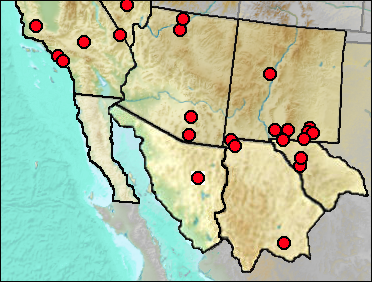
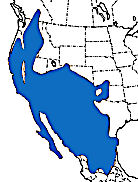 Although traditionally considered a member of the
Vespertilionidae, some bat taxonomists recognize it as a member of the family Antrozoidae and as
more closely aligned with the molossid than the vespertilionid bats (Simmons and Conway 1997).
Although traditionally considered a member of the
Vespertilionidae, some bat taxonomists recognize it as a member of the family Antrozoidae and as
more closely aligned with the molossid than the vespertilionid bats (Simmons and Conway 1997).
Fig. 1. Modern distribution of the Pallid Bat. Adapted from Hermanson and O'Shea (1983).
The Pallid Bat is a common member of the bat fauna throughout the lowlands of our region and can be found up into the lower portions of woodlands and coniferous forests. Although it may utilize caves, it often inhabits attics of dwellings and crevices formed by loose building siding and the like.
Unlike the various species of Myotis, Antrozous pallidus can be identified with confidence on various elements.
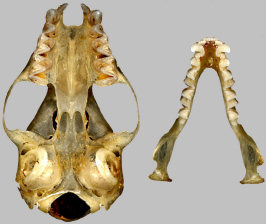
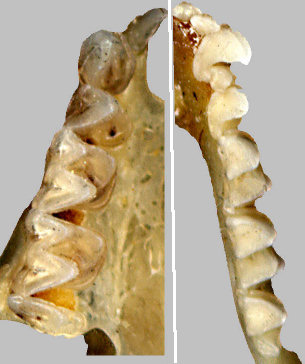
Fig. 2 (left). Ventral view of the skull of Antrozous pallidus. Fig. 3 (right). Upper and lower right tooth rows of Antrozous pallidus. The teeth of this specimen are greatly worn. Fig. 4. Ventral view, partial skull of Antrozous pallidus from Dark Canyon Cave. UTEP catalogue no. 75-92. Millimeter scale.
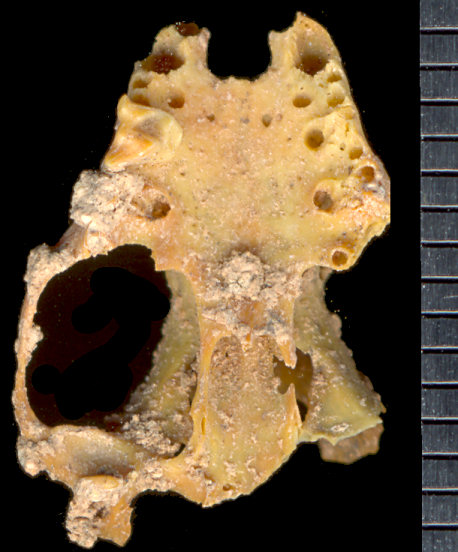
Sites.
Rancholabrean: Cool Water Coal Gasification Solid Waste Site (Jefferson 1991b); Papago Springs Cave (Skinner 1942).
Sangamon: Newport Bay Mesa (Jefferson 1991b).
Early/Early-Mid Wisconsin: Lost Valley (Harris 1993c).
Mid Wisconsin: McKittrick (Schultz 1937); Pendejo Cave (Harris 2003); Tank Trap Wash (Van Devender et al. 1987); Térapa (Czaplewski et al. 2014); (U-Bar Cave (Harris 1987).
Mid/Late Wisconsin/Holocene: Jimenez Cave (Messing 1986); Rancho La Brea (Stock and Harris 19920; Sierra Diablo Cave (UTEP).
Mid/Late Wisconsin: Bida Cave (Mead et al. 2005); Dark Canyon Cave (Tebedge 1988); Pintwater Cave (Hockett 2000); Sandblast Cave (Emslie 1988).
Late Wisconsin: Antelope Cave (Reynolds, Reynolds, Bell, and Pitzer 1991); Bennett Ranch #5 (Van Devender and Bradley 1990); Dust Cave (Harris and Hearst 2012); Muskox Cave (Logan 1981); U-Bar Cave 13-14 ka (Harris 1989); U-Bar Cave 14-15 ka (Harris 1989); U-Bar Cave 18-20 ka (Harris 1989) Upper Sloth Cave (Logan and Black 1979).
Late Wisconsin/Holocene: Conkling Cavern (UTEP); Deadman Cave (Mead et al. 1984); Howell's Ridge Cave (Harris 1993c); Isleta Cave No. 1 (UTEP); Kokoweef Cave (Reynolds, Reynolds, et al. 1991); Pendejo Cave (Harris 2003).
Literature.
(Czaplewski et al. 2014); Emslie 1988; Harris 1987, 1989, 1993c, 2003; Harris and Hearst 2012; Hermanson and O'Shea 1983; Hockett 2000; Jefferson 1991b; Logan 1981; Logan and Black 1979; Mead et al. 1984, 2005; Messing 1986; Reynolds, Reynolds, et al. 1991; Reynolds, Reynolds, Bell, and Pitzer 1991; Simmons and Conway 1997; Schultz 1937; Skinner 1942; Stock and Harris 1992; Tebedge 1988; Van Devender and Bradley 1990; Van Devender et al. 1987.
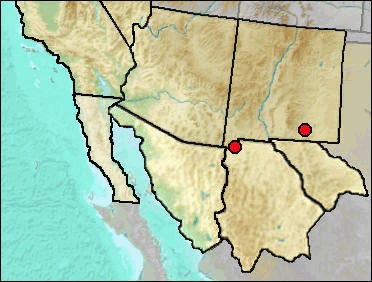
Synonyms. Plecotus.
After an earlier period of being assigned to the genus Corynorhinus, the big-eared bats were long placed in the genus Plecotus. Now the New World populations are placed back in the genus Corynorhinus, with the recognition that the genus Plecotus should be restricted to the Old World.
At one time, Idionycteris phyllotis (Allen's Big-eared Bat) was included in the genus. It's a distinct possibility that bats identified in the literature only as Corynorhinus could be that species. The genus Euderma (Spotted Bat) also is closely related, but there is little osteological material of this rare bat available for comparison.
Sites.
Early/Early-Mid Wisconsin: Lost Valley (Harris 1993c); Rm Vanishing Floor (Harris 1993c).
Mid/Late Wisconsin: Animal Fair (Harris 1993c).
Late Wisconsin: Bison Chamber (Harris 1993c); U-Bar Cave 13-14 ka (Harris 1989); U-Bar Cave 18-20 ka (Harris 1989); Upper Sloth Cave (Logan and Black 1979).
Late Wisconsin/Holocene: Balcony Room (Harris 1993c).
Literature. Harris 1989, 1993c; Logan and Black 1979.
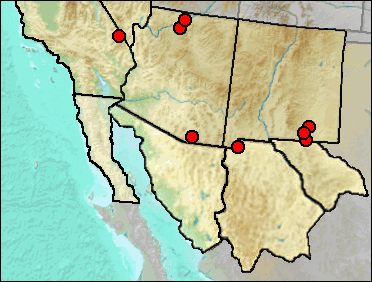
Synonyms. Plecotus townsendii.
Townsend's Big-eared Bat is widespread in the region today, though human impact is taking its toll and it is considered vulnerable. Roosting usually is in the twilight zone of caves and mines.
Sites.
Mid Wisconsin: Papago Springs Cave (Czaplewski and Mead et al. 1999); U-Bar Cave (Harris 1993c).
Mid/Late Wisconsin: Bida Cave (Mead et al. 2005); Sandblast Cave (Emslie 1988).
Late Wisconsin: Animal Fair 18-20 ka (Harris 1989); Dust Cave (Harris and Hearst 2012); Harris' Pocket (Harris 1970a: cf.); Lower Sloth Cave (Logan 1983); Muskox Cave (Logan 1981); U-Bar Cave 14-15 ka (Harris 1989); U-Bar Cave 15-18 ka (Harris 1989).
Late Wisconsin/Holocene: Kokoweef Cave (Reynolds, Reynolds, et al. 1991).
Literature. Czaplewski and Mead et al. 1999; Emslie 1988; Harris 1970a, 1989, 1993c; Harris and Hearst 2012; Logan 1981, 1983; Mead et al. 2005; Reynolds, Reynolds, et al. 1991.
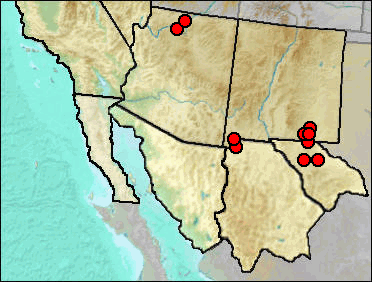
The Big Brown Bat occurs throughout the region, though generally less common in desert than at higher elevations.
Sites.
Mid Wisconsin: U-Bar Cave (Harris 1987).
Mid/Late Wisconsin: Bida Cave (Mead et al. 2005).
Mid/Late Wisconsin/Holocene: Sierra Diablo Cave (UTEP).
Late Wisconsin: Animal Fair 18-20 ka (Harris 1989); Bison Chamber (Harris 1970a); Dust Cave (Harris and Hearst 2012); Harris' Pocket (Harris 1970a); Lower Sloth Cave (Logan 1983); Muskox Cave (Logan 1981); Stanton's Cave (Olsen and Olsen 1984: cf.); TT II (Harris 1993c); U-Bar Cave 13-14 ka (Harris 1989); U-Bar Cave 14-15 ka (Harris 1989); Upper Sloth Cave (Logan and Black 1979).
Late Wisconsin/Holocene: Balcony Room (Harris 1993c); Carlsbad Cavern (Harris 1993c); Fowlkes Cave (Dalquest and Stangl 1984); Howell's Ridge Cave (Harris 1993c).
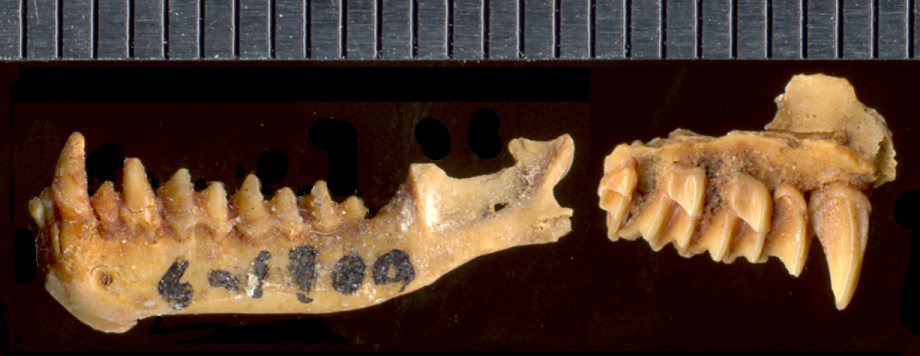
Fig. 1. Left dentary with i2-3 c1 p3-4 m1-3 and left maxilla with C1 P4 M1-3. Fossil specimens (UTEP 6-1900 and 6-343) from Harris' Pocket, Dry Cave. Scale in mm.
Literature. Dalquest and Stangl 1984; Harris 1970a, 1987, 1989, 1993c; Harris and Hearst 2012; Logan 1981; 1983; Logan and Black 1979; Mead et al. 2005; Olsen and Olsen 1984.
Last Update: 7 Oct 2019